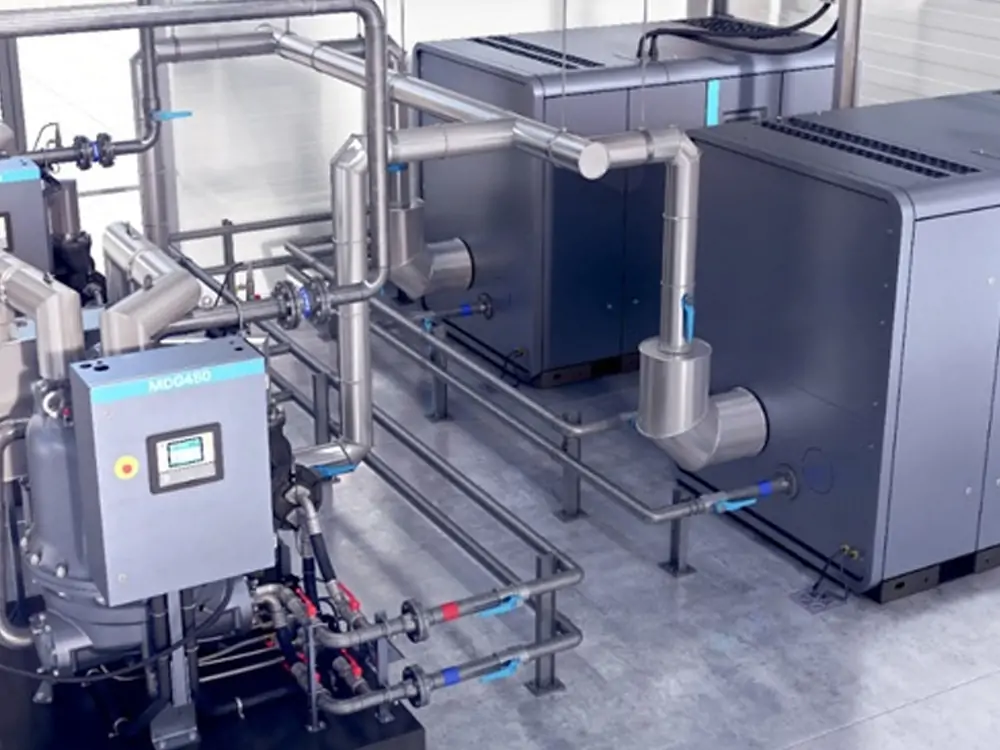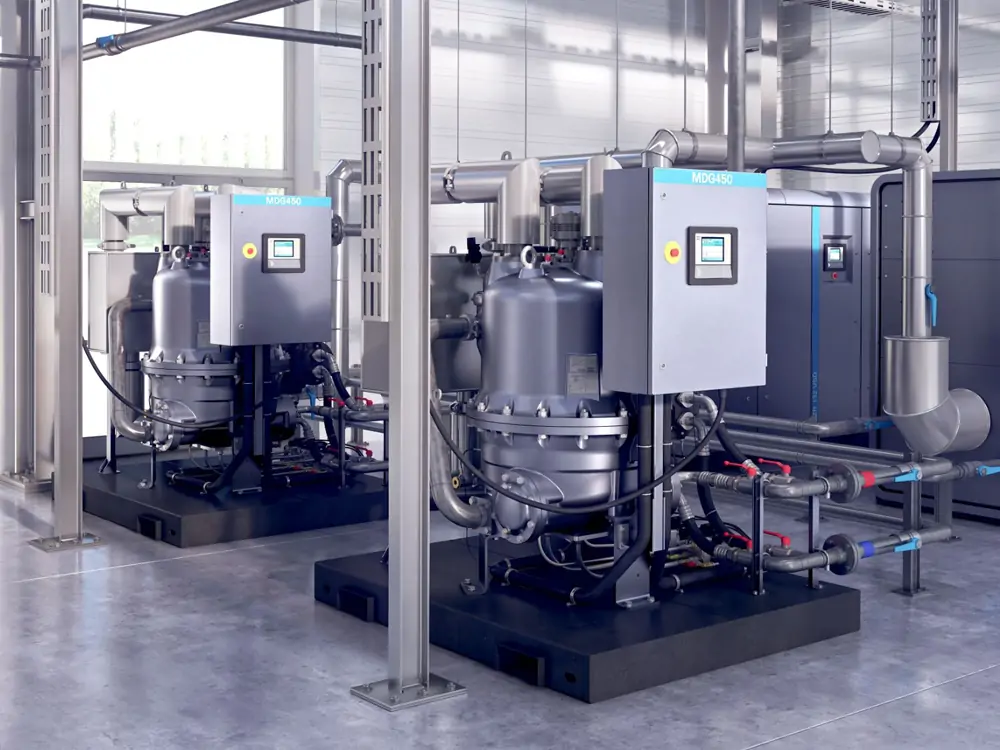Le sécheur à compresseur d'air est un élément essentiel des systèmes d'air comprimé. Inévitablement, il y aura de l'humidité pendant le fonctionnement du compresseur d'air. It can contaminate the end product and damage our production equipment and components. This is why it must remove this moisture in the compressor system. Compressed air dryers are the devices that help dry the wet air. Cela garantit la qualité de votre air comprimé. Mais pour toi, what is the best air dryer for air compressors? Et comment les sélectionner?
Whether you are an engineer, technician, or manufacturer, this article will provide in-depth insights and guidance on this critical topic. Let’s choose the right drying solution for your air compression system.
How Do You Select The Air Dryer For Air Compressor
It must know the following parameters to choose the right compressed air dryer. Let’s talk about it.
Capacité aérienne
The air compressor dryer can handle this maximum flow of compressed air. Premièrement, the user needs to determine this value based on the consumption of all air-consuming equipment and the usage factor. Bien sûr, si vous avez déjà un compresseur d'air, you can send the nameplate to the manufacturer.
As a professional air compressor dryer manufacturer, nous vous disons de manière responsable. Si vous utilisez beaucoup d'air, choose a compressed air dryer with a larger capacity. C'est, la capacité d'air du sécheur doit être supérieure à celle du compresseur d'air. Parce qu'en période de température et d'humidité élevées, la teneur en eau de l'air augmente. En ce moment, the dryer machine is overloaded. Donc, the drying effect will decrease. Cela peut causer de nombreux problèmes, tels que de grandes quantités d'humidité et une panne d'équipement.
Pression d'air d'entrée
Different air pressures and different air capacities of the dryer. Les pressions courantes dans la production industrielle vont de 0,6 MPa à 1,0 MPa. Donc, the most common is the normal pressure air compressor air dryer.
Cependant, d'autres industries ont des exigences de pression différentes. Par exemple, l'industrie du laser exige généralement 16 barres. Some industries require high-pressure compressed air dryers. Notre société peut personnaliser des séchoirs jusqu'à 100 bar.
Inlet Air Temperature And Ambient Temperature
La température est essentielle au choix du sécheur à compresseur d'air. Par exemple, il existe deux types de sécheurs d'air réfrigérés. Namely normal temperature (50°C) and high temperature (80°C). The temperature is very high in Pakistan and the Middle East in summer. First, it must choose a high-temperature type of refrigerant dryer. De plus, nous devons souvent choisir un modèle plus grand. This not only achieves good water removal but also avoids dryer downtime.
D'autre part, la température de l'air d'entrée du sécheur d'air par adsorption ne doit généralement pas être supérieure à 40 °C. If the temperature is too high, l'effet d'élimination de l'eau de l'adsorbant sera fortement réduit. Bien sûr, it can choose the HOC type desiccant dryer now.
Dew Point Requirement of Air Compressor Dryer
Different dew point requirements and different equipment configurations. Naturellement, the price is different. Les sécheurs frigorifiques ont généralement un point de rosée sous pression de 2 à 10°C. There are different conditions and different dew points. Par exemple, refrigerant compressed air dryers can achieve a very low dew point. Mais il nécessite une condition de fonctionnement standard de 25°C et 7 bar.
Différentes industries ont des exigences différentes pour les points de rosée. Voici quelques exemples.
- Industrie pharmaceutique: le point de rosée est d'au moins -40°C.
- Industrie des PCB: le point de rosée doit atteindre -20°C.
- Industrie de la séparation gaz-air: le point de rosée doit être de -70°C.
Choose a combination dryer if you require a dew point of -70°C. Ou il doit y avoir un sécheur frigorifique et des filtres avant le sécheur d'air à adsorption.
Voltage And Frequency
Cela varie d'un pays à l'autre. Par exemple, en Amérique du Nord, 220V/60HZ/monophasé et 380V/60HZ/triphasé sont communs. À ce moment là, il faut personnaliser le compresseur frigorifique. Parfois, le prix du teinturier sera également différent.
Raw Materials
Some industries have requirements for the material of air compressor dryers. Par exemple, the pharmaceutical industry requires stainless steel. Dans ce cas, la tuyauterie et le système d'échange de chaleur doivent être SS304. Et la tour d'adsorption a également besoin de SS304. En outre, l'industrie des batteries au lithium a également besoin d'acier inoxydable.
Le séchoir en inox sera plus cher. Bien sûr, you can choose the Lingyu PD series refrigerated air dryer. You can also choose the modular desiccant compressed air dryer. Ils peuvent également répondre aux exigences des industries alimentaires et pharmaceutiques.
Environmental Requirements
Le réfrigérant habituel des sécheurs d'air par réfrigération est le R22. Il est courant dans les pays en développement. Cependant, Les pays européens et américains exigent des réfrigérants respectueux de l'environnement. Pour nous, R134a, R407C, R410a sont disponibles. The dryer is a little more expensive if you want an eco-friendly refrigerant.
Air Cooled vs. Water Cooled Refrigerated Compressor Air Dryer
Le sécheur d'air réfrigérant à petit débit est refroidi par air. Notre sécheur refroidi par air peut aller jusqu'à 120 m³/min. Si dessus 120 m³/min, the air compressor air dryer is water-cooled.
For high-flow dryers, the size will be very large if you need an air-cooled type. Par exemple, ce sera aussi haut que plusieurs étages. Et l'efficacité de l'échange de chaleur sera bien pire. The water-cooled dryer is not affected by a high-temperature environment. Bien sûr, there needs to be a cooling water system. Cela va donc augmenter le coût.
Energy Saving Requirements
① Fixed vs. Variable Frequency Refrigerated Air Dryer
We commonly use fixed-frequency air compressor dryers. Il peut répondre à la sortie maximale. Cependant, in actual production activities, la demande en air varie. Aux petites demandes, il fonctionne toujours à la puissance maximale. Cela entraîne un gaspillage d'énergie. Au contraire, the output of the variable frequency dryer can match the air demand. Cela se traduit par d'importantes économies d'énergie et de coûts d'exploitation.
② Choice of Desiccant Dryer Regeneration Method
The heatless compressed air dryer has a small power of ~0.1 kW. But it has a big air consumption of about 15%. C'est une forte consommation d'énergie. Le sécheur par adsorption à micro-chauffage consomme généralement environ 8% d'air de régénération. Par rapport au sèche-linge sans chaleur, ça peut sauver 40% d'énergie.
Le sécheur par adsorption sans perte d'air consomme 0% air de régénération. A heatless air compressor air dryer can save 70% d'énergie. Bien sûr, it is more expensive.

How to Size The Air Dryer For Air Compressor?
Sizing an air dryer for air compressor involves determining the appropriate capacity and specifications of the dryer. So it can remove moisture and contaminants from the compressed air effectively. The sizing process ensures that the air dryer can handle the air volume and achieve the desired dew point, maintaining the compressed air quality.
Here are the steps to size an air compressor air dryer.
Determine Compressed Air Flow Rate (PCM)
Measure or calculate the maximum compressed air flow rate that your air compressor system requires. This is usually expressed in cubic feet per minute (PCM). It is a crucial parameter for sizing the air dryer.
Calculate Inlet Air Temperature And Pressure
Determine the temperature and pressure of the compressed air at the dryer’s inlet. This information is necessary to calculate the corrected flow rate and dew point.
Consider Ambient Conditions
Account for variations in ambient temperature and humidity, as these can affect the performance of the air dryer. Understanding the environmental conditions helps in selecting the appropriate dryer type and specifications.
Determine Required Dew Point
Define the desired dew point or moisture level for your application. The dew point is the temperature at which air becomes saturated with moisture and starts to condense. Choosing a dew point suitable for the application is crucial to prevent potential issues.
Select The Right Type of Compressed Air Dryer
Choose the appropriate type of air dryer based on the required dew point and application. Common types include refrigerated dryers, desiccant dryers, and membrane dryers. Each type has specific advantages and is suitable for different dew point requirements.
Calculate The Corrected Flow Rate
Adjust the compressed air flow rate for the actual conditions using the information gathered earlier. Correcting for temperature and pressure ensures that the air dryer is sized accurately.
Consult Manufacturer Specifications
Refer to the manufacturer’s specifications and performance data for the selected air dryer type. So it can verify that it can handle the corrected flow rate and achieve the desired dew point.
Account For Safety Factors
Consider adding a safety factor to ensure the air dryer can handle variations in air demand and operating conditions, providing a buffer for unexpected fluctuations.
Choose The Appropriate Air Dryer Size
Based on the corrected flow rate, dew point requirements, safety factors, and manufacturer specifications, select the suitable size and model of the air dryer that meets the system’s needs.
Installation And Monitoring
Install the chosen air dryer correctly within the compressed air system. Regularly monitor its performance and maintain it according to the manufacturer’s recommendations to ensure optimal efficiency and reliability.

Conclusion
In modern industry, compressed air dryers are an indispensable tool. They provide continuous and stable high-pressure air for a variety of applications. Cependant, to ensure reliable operation and extend the compressor’s life, air quality management becomes critical. Selecting and sizing the right compressor air dryer is one of the important steps in ensuring good operation.
By following these steps and considering the specific requirements of your air compressor dryer system, you can accurately size an air dryer to maintain the desired air quality and enhance the overall efficiency of the compressed air dryer system.
